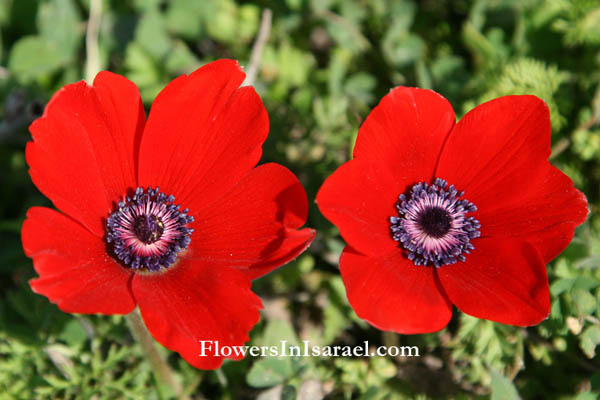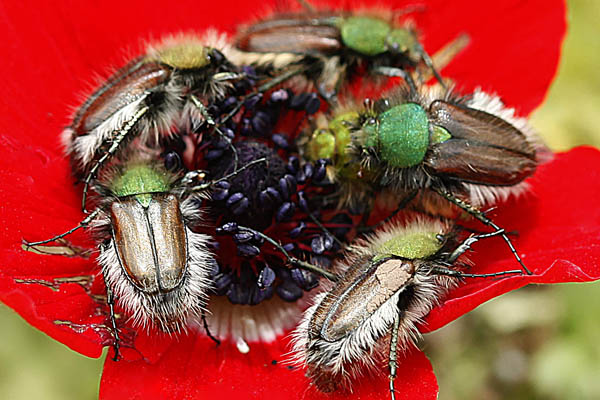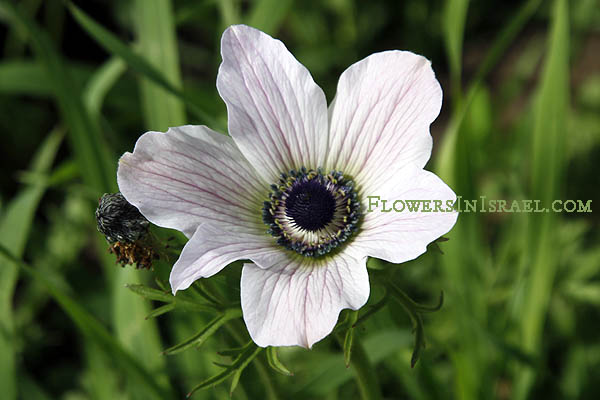Hebrew: כלנית מצויה, Arabic: شقائق النعمان , دحنون
| Scientific name: | Anemone coronaria L. | |
| Common name: | Crown Anemone | |
| Hebrew name: | כלנית מצויה | |
| Arabic name: | شقائق النعمان , دحنون | |
| Family: | Ranunculaceae, נוריתיים |

Honeybees are the main anemone visitors during the first seven weeks of flowering |
| Life form: | Geophyte | |
| Stems: | 15-45 cm high | |
| Leaves: | Rosette, dissected twice or more, dentate or serrate; basal leaves deeply cut | |
| Inflorescence: | Solitary; conspicuous | |
| Flowers: | 3.5-6.5 cm in diameter; perianth segments 5-8, elliptical, light blue, pink, purple, red, violet, white; anthers blue | |
| Fruits / pods: | Achene | |
| Flowering Period: | January, February, March, April, December | |
| Habitat: | Batha, Phrygana, Shrub-steppes | |
| Distribution: | Mediterranean Woodlands and Shrublands, Semi-steppe shrublands, Shrub-steppes, Deserts and extreme deserts, Montane vegetation of Mt. Hermon | |
| Chorotype: | Mediterranean | |
| Summer shedding: | Ephemeral |

Derivation of the botanical name: Anemone, anemos (Greek), "wind". In Greek mythology, Anemone was the name of the daughter of the winds. coronaria, corona (Latin), "crown"; coronaria, used for garlands, or pertaining for garlands. The Hebrew name: כלנית, kalanit, from כלה, kala, 'bride', Aramaic: כולנייתא, as the anemone is as beautiful and majestic as a bride on her wedding day. Immanuel Löw (1854 – 1944), a Hungarian rabbi, scholar and politician, gave the name Kalanit. Apparently, the name is derived from the "Kalanthha" plant mentioned in the Babylonian Talmud.
Anemone coronaria is traditionally identified as the `lily of the field'. In Hebrew the flower is called Kalanit. The name Kalanit (כלנית מצויה) is derived from Kala (כלה), as the beautiful and majestic anemone is like a bride on her wedding day. Apparently, the name is derived from the plant "Clnita, כלניתא" mentioned in the Babylonian Talmud, Pesachim, page 35, Page A (בתלמוד בבלי, מסכת פסחים, דף ל"ה, עמוד א). It was Lőw Immánuel (עמנואל לעף 1854-1944), who gave the plant its hebrew name. Lőw Immánuel, a Hungarian botanist and linguist, spent decades trying to identify all the plants mentioned in Jewish sources. The monumental study was published in in his four volume work Die Flora der Juden (“The Flora of the Jews”), on terminology of plants in Jewish sources. Anemone probably appears Isaiah 17:10 New International Version (NIV)as Namnim: "You have forgotten God your Savior; you have not remembered the Rock, your fortress. Therefore, though you set out the finest plants and plant imported vines". The Anemone in Myth: Venus/Aphrodite creates the short-lived anemone flower from the blood of Adonis, who was killed by Apollo in the form of a boar. To some, this flower has come to represent the goddess's short-lived lover, and it takes its name from the wind which so easily makes its petals fall. The Anemone coronaria is a widespread herbaceous perennial plant growing to 20-40 cm tall (rarely to 60 cm), with a basal rosette of a few leaves, the leaves with three leaflets, each leaflet deeply lobed. The flowers are borne singly on a tall stem with a whorl of small leaves just below the flower; the flower is 3-8 cm diameter, with 5-8 red, white or blue petal-like sepals. Recent research in Israel has shown that there is a genetic basis for this variation which explains for the dominance of a certain colour in a particular region. Around Jerusalem, for instance, the red shape is more frequent than the blue, while on the basalt slopes north the Sea of Galilee the hillside are speckled with the blue and white flowers. The “Red Anemone Guild Flowers” comprises some of the species from six plant genera (Anemone, Tulipa, Ranunculus, Adonis, Glacium and Papaver) that belong to three phylogenetically distant families (Ranunculaceae, Liliaceae and Papaveraceae). "Honeybees are the main anemone visitors during the first seven weeks of flowering, and were joined by Glaphyrid beetles in the remaining three weeks" (Avi Shmida, Dept. Evolution, Systematics & Ecology & Center for the study of Rationality, The Hebrew University, Jerusalem 91904, Israel). The pollination of the "Red Anemone Guild" is by Glaphyrid beetles (Scarabaeoidea). Flowers of this guild are characterized by large, red bowl-shaped petals that surround a large black mass containing the anthers and the female reproductive organs, they close at night. Closing of the petals at night not only protects flowers from cold and rain, but also provides an overnight shelter for potential pollinators. Glaphyridae regularly shelter at night within the closed flowers of Anemone. Glaphyridae result to be the primary pollinator of Anemone coronaria, Papaver rhoeas, Ranunculus asiaticus and Tulipa agenensis. Anemones need light. Spalax, mole-rats (חולד ארצישראלי) like Anemones and Irises. In Israel we don't have moles (חפרפרות). Three Sisters, an Israeli Fairy tale Once upon a time, in a far country, there lived a handsome prince. After years of dissipation and tumultuous bachelorhood the prince decided to take a woman in his life, and announced that he would give an evening of “Speed Dating”, free and open to the female audience. Hundreds of women decided to try their luck, including the Three Sisters: Anemone, Scarlet Crowfoot and Poppy. On the appointed day the sisters (like most invited) stormed the nearby mall to get the most up to date garment and the most impressive accessories. The mall was full of women pushing and shopping to get an outfit. Within minutes the sisters had lost each other and only met again when they returned to their homes, each with the result of her shopping frenzy, all with the same red dress. Trouble!? How could the Prince distinguish between the three? After the tears, the blood returned to their faces, and they found a solution: each of them would add a rather unique accessory to her red dress. Anemone added a white scarf she brought from her travels in India. Scarlet Crowfoot (Ranunculus), the trendy, added a green belt, decorated her dress with glitters and put on glossy lipstick. Poppy wore a black beaded necklace around her neck. With the upgraded performance they entered the hall and seized the prince's heart within minutes. He spent an entire day with every one of them, and after three days he admitted he could not reach a decision. The three sisters were also captured by the prince’s charms, and each wanted him for herself. Wow, and another solution was found: the Prince would marry the three of them, on condition that once a year, every year, he will dedicate a period of time with each one separately. The Prince in love quickly agreed, and only asked the sisters to continue to wear their special accessories to avoid unnecessary confusion and shame. For the same reason he also decided to open a log book and to set dates for each sister, in alphabetical order – Anemone, Scarlet Buttercup, Poppy. Since then, every year, Anemone is the first to bloom, with a white scarf around the stamens, Scarlet crowfoot with the bright shiny leaves and the typically green sepals enclosing the petals in the form of a belt, is the second to appear and Poppy finishes the cycle, with dark circles on the petals. So now you can distinguish the difference between an anemone and poppy. Bible resources:





 Glaphyrid beetles 



|